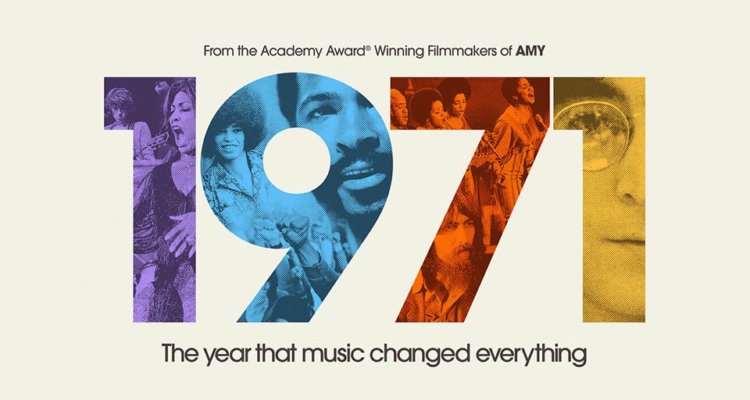Studying the cultural and political revolutions of the late 60s and early 70s won’t earn you any points for originality. It’s not that this period in world history isn’t important — it’s continually worthy of assessment, if only because history, as you know, repeats itself. Just look at the Trump years, the pandemic, and the years of protest over racial discrimination and police brutality — they mimic how Western culture shifted during the Civil Rights movement, the anti-Vietnam War/Nixonism protests, and the countercultural movement to push against the 50s Howdy Doody nuclear family, structural biases and lingering stains of McCarthyism.
READ MORE: Summer 2021 Preview: Over 50 Movies To Watch
The music, of course, stands as a mirror to the time, with cultural luminaries like Marvin Gaye, The Rolling Stones, Bob Dylan, John Lennon, Aretha Franklin, Bob Marley, Carole King, Gil Scott-Heron, The Who, Joni Mitchell, David Bowie, Sly Stone, Sir Elton John and countless others weaving narratives of all kinds to commemorate how the world was changing, for the better and for the worse. AppleTV+‘s docuseries “1971: The Year That Music Changed Everything” might not have the artistic flash and urgency of Questlove‘s bombastic upcoming directorial debut “Summer of Soul (…Or, When the Revolution Could Not Be Televised)” or an unforgettable aura like the brilliant unearthed Franklin concert film “Amazing Grace.” However, it does serve as an educational tool to help curious onlookers who might not have a full grasp of the cultural importance the year held. If you’re a fan of the era or love looking back on how the tectonic plates of music shifted to produce some of the medium’s defining works, you’ll dive in swimmingly. If you’ve exhaustingly studied the time frame, this might reinforce what you already know.
READ MORE: The 65 Most Anticipated TV Shows & Mini-Series Of 2021
Like 2019’s “Apollo 11,” “1971: The Year That Music Changed Everything” eschews the talking head format to piece together a bevy of footage and audio clips from the players at hand (including deceased figures like Lennon and Nixon) into eight comprehensive, if ambitious, episodes from directors Asif Kapadia (“Senna,” “Amy“), Danielle Peck and James Rogan. Kapadia, in particular, has made a career of these types of documentaries — unintrusive, observant works that allow history to speak for itself rather than shoehorn in a modern perspective. By doing this, you cut through the fat and get right to the center of the drama. It’s not always the best way to document history, but done the right way, it can compel in ways that the traditional documentary just can’t.
READ MORE: Summer TV Preview: Over 40 Series To Watch
This AppleTV+ docuseries tries to cover a lot of ground (after all, a lot happened in 1971). By and large, the doc series successfully captures the mood of how people felt and how vital the cultural shifts were to lay the foundation for everything that came after it. Through countless films, albums, documentaries, books, and history lessons, we all know about the artists, politicians, activists, and other key figures of the time. Their stories are not hidden — we know how their music spoke to racial injustice, the anger for Vietnam and Nixon’s administration, the fatigue of systemic policies holding people down, the explosion of free love and recreational drug use. It’s well-worn ground.
READ MORE: The 25 Best TV Shows & Mini-Series Of 2020
Though, what “1971” does best understands the power of visuals paired with the music. Of course, public opinion of the Vietnam War changed rapidly once the visuals of what was happening began circulating en masse on televisions across the country. It was the same for the Civil Rights movement; Ava DuVernay‘s masterwork “Selma” showcases how Martin Luther King, Jr. understood the power of television, how Americans needed to see the suffering of Black Americans to kickstart their collective empathy with King’s righteous cause. This documentary series’ greatest strength isn’t in its editing like its peers — it’s in the vibrancy and potency of its footage. The concert and recording footage is spiced with scenes of historical context and compelling interviews; songs are identified clearly with lyrics put on the screen; it can be quite compelling when it really clicks.
At times, though, the assembly can be a little scattershot, almost trying to chew too much before it swallows. Its eyes can be a little bigger than its stomach. We jump around so much that, while each episode has a thesis, we don’t get to spend too much time really digging into each story, person and situation. Something more contained, like “Summer of Soul” or “Amazing Grace,” hits you harder because it focuses on one person and one moment in time. You get the full tidal wave of artistry and why it was so era-defining. “1971” wants to paint a picture of the full moment, and by doing so, it doesn’t quite give you that intimacy.
Even so, “1971” is still well worth the price of admission. The first scene in the series hits you right away with Crosby, Stills, Nash, and Young‘s seminal “Ohio,” set against the senseless shootings of students at Kent State by the Ohio National Guard in 1970. While the song was released a year earlier than the series surveys, you feel the mourning, fear, blistering rage, and confusion; it sets a heck of a tone. The series is at its best when it marries the intensity of the moment’s sound with the power of its visual memories. When everything collides, you really feel the temperature of how life was when music was helping morph how the world operated. It’s a stirring reminder of how not much has changed and how we continue to see art and politics converge to create reality. [B]

